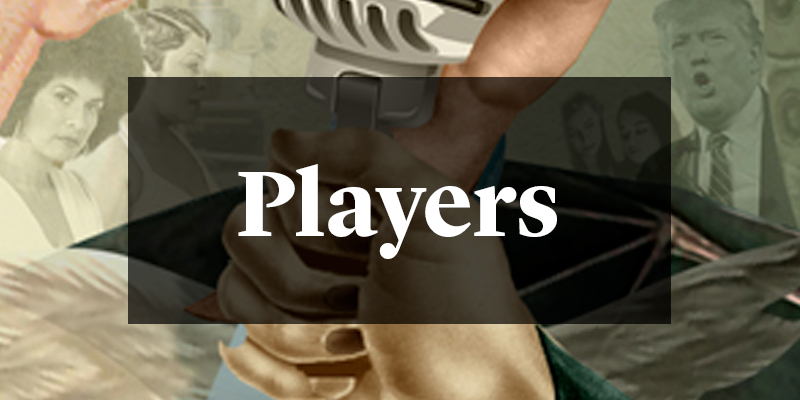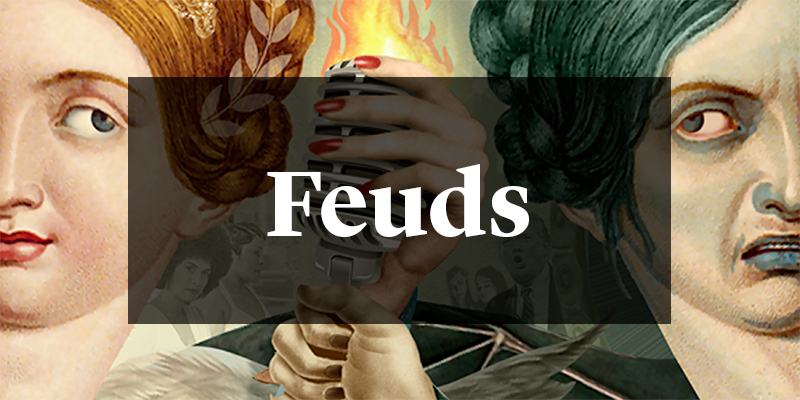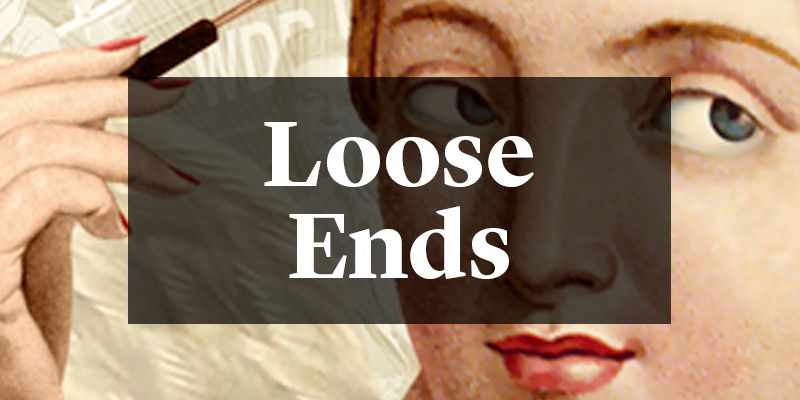It was a year dominated by a focus on our press-bashing president, when the scoops and push alerts threw the news cycle into overdrive. It was a year that saw continued financial challenges, and it ends with the industry in the midst of a reckoning in which it is both pushing the story forward and turning the lens on itself. As 2017 comes to a close, here are CJR’s awards, trends, players, feuds, and loose ends from the year that was.

CJR’s Journalists of the Year
The current moment of reckoning with sexual assault and harassment across numerous industries was catalyzed by the reporting of a quintet of journalists. The New York Times’s Jodi Kantor and Megan Twohey won the race to break the Harvey Weinstein story, while Ronan Farrow’s dogged reporting for The New Yorker helped push the story forward. Kantor and Twohey’s Times colleagues, Emily Steel and Michael Schmidt, heralded this moment in the spring with their work exposing Bill O’Reilly’s history of harassment and abuse at Fox News. Rarely has news reporting resulted in so much change in so little time.
TRENDING: Journalists have something new to worry about in February
The CJR award for best local investigation
The Los Angeles Times exposed the shocking secret life of USC’s medical school dean, while The Tampa Bay Times spent three years tracking police shootings in the country’s third-largest state. But the cream of the crop was The Cincinnati Enquirer’s “Seven Days of Heroin,” a devastating exercise in understated, observational journalism.
Most “novel” approach to storytelling
S-Town, the groundbreaking podcast from the creators of Serial and This American Life, strayed from standard conventions of audio storytelling when it launched in March, taking a more novelistic approach to narrative. The show’s host, Brian Reed, introduced the world to John B. McLemore, an eccentric antique horologist from smalltown Alabama and a character seemingly ripped from the pages of a classic Southern Gothic novel.
Best collaboration
A network of nearly 400 journalists from dozens of nations worked together, in secret, to expose the shaddy financial practices of the global elite. The Paradise Papers were born from a leak of more than 13 million documents to German newspaper Süddeutsche Zeitung and were the product of the International Consortium of Investigative Journalists, as well as reporters from outlets around the globe.
Hurricane coverage highlights and lowlights
In the midst of a crisis predicted a year before, scenes of journalists engaged in dramatic rescues highlighted reporting out of Houston. CNN’s Bill Weir and CBS’s David Begnaud did their best to bring attention to the crisis following Hurricane Maria in Puerto Rico, where journalists often served as lifelines to those trying to connect with family members. You weren’t mistaken, the media really did neglect Puerto Rico following Maria. In late September, FiveThirtyEight’s Dhrumil Mehta showed that, “compared to the other natural disasters of the past few weeks, Hurricane Maria has been relatively ignored.”
TRENDING: A “shameless, extreme response” to a Fox News segment
How to cover white supremacy
As tiki-torch wielding young men marched through the streets of Charlottesville in August, Vice News Tonight was there to chronicle the chaos. Reporter Elle Reeve captained a stunning piece of journalism that deserved all the plaudits it received. Just before Thanksgiving, The Atlantic’s Adam Serwer explored the historical roots of “a time-honored American political tradition,” while Luke O’Brien demonstrated how to profile an abhorrent figure for The Atlantic.
Worst roll-out of a non-scoop
When MSNBC’s Rachel Maddow teased her March 14 show with the promise “We’ve got Trump tax returns…(Seriously),” it seemed she had scored a coup that journalists had spent the past year searching for. That night, it took nearly 20 minutes, and a commercial break, for Maddow to bring out investigative reporter David Cay Johnston, who revealed two rather uninteresting pages of Trump’s 2005 tax return.
if you have news, Rachel, please tell us. soon. I'm not young.
— Bob Ley (@BobLeyESPN) March 15, 2017
Tronc© award for worst new media name
Winner: Oath, the banal, corporate-speak creation arising from Verizon’s melding of AOL and Yahoo!
Honorable mention goes to Splinter and Axios (apparently we’ve all been saying it wrong…it’s Ax-ee-us).
A pivot to video that’s actually worked
The New York Times’s jump into audio may get more of the attention, but the outlet’s development of its video unit also deserves notice. Under the leadership of Malachy Browne, the Times’s video forensics team stitched together dozens of angles to produce a stunning piece of journalism on the attack of protesters in Washington, DC by Turkish President Recep Tayyip Erdogan’s security detail, and provided clarity to the chaos that took place when a gunman opened fire in Las Vegas.

A Trump bump to the bottom line
As Trump lambasted media outlets as purveyors of “fake news,” consumers lined up to support them. The “failing” New York Times and the “Amazon” Washington Post both reported subscriber surges under Trump, while Vanity Fair, whose editor, Graydon Carter, spent much of his career ridiculing Trump, also saw a rise in subscriptions.
The rise and fall of the pro-Trump press
Trump’s rise was fueled in part by a traffic boom to conservative sites like Breitbart and The Daily Caller, but a year after his election those outlets have seen their audience numbers collapse or decline. Meanwhile, more mainstream (and more liberal) publishers have experienced a bump in traffic.
#MeToo #MeToo #MeToo
The final quarter of 2017 has been dominated by stories of sexual misconduct by powerful men. After Kantor, Twohey, and Farrow set this moment in motion, reporters at news outlets ranging from The Daily Beast and The Huffington Post to The Hollywood Reporter and beyond found sources more willing to speak out and say #MeToo. The result has been a dramatic flood of stories that have taken down some of the most powerful men in media, film, politics, and tech, while elevating women’s voices that have too long been silenced.
The year we dreaded glancing at our phones
This was the year that news flew so fast that the time it took to click a link or unlock our phone meant we were already behind. Push alerts, born of “the convergence of Trump and technology and the media landscape,” brought us bubbles of information, ramping up blood pressure and signaling that, as long as your phone was in your pocket, you were never free from the churn.
When that New Yorker cartoon of flyover country becomes real life
Excursions into the heartland became a favorite genre of political reporting in the months following Trump’s victory. Halfway through the year, CJR’s David Uberti linked eight adventures in Trumplandia: “Virtually all national outlets have run some version, and likely multiple versions, of a story taking the temperature of Trump country, be it a hard-on-its-luck coaltown in Appalachia or a hollowed-out manufacturing hub in the upper Midwest.” The most glaring offense came via The New York Times, which quoted the same Trump-supporting small business owner in two separate stories.
Winter arrives for digital media
This was the year in which investors realized there may be no pot of gold at the end of the digital-media rainbow. BuzzFeed and Vice are both expected to miss their revenue targets by significant amounts, and Mashable was sold for a fraction of the value it was pegged at just a year ago. With even the digital darlings struggling, the future looks bleak for ad-supported media.
Pivot to Video: 2017-2017
“Pivot to video” was 2017’s hottest media trend, with outlets like Mic, MTV News, Mashable, and Vice embracing the strategy, laying off dozens of written-word journalists in the process. The strategy resulted in traffic plunges and flat-out bad journalism, as the cost of doing what Facebook and advertisers want became clear.
A long wind-down for alt weeklies
With the possible exception of local newspapers, no medium has been hit harder by journalism’s financial reckoning than alternative weeklies. After years of closures at smaller papers, that reckoning came for some of the industry’s biggest names. The iconic Village Voice printed its last physical issue in September, LA Weekly has been gutted by new owners, and staffers at Washington City Paper are facing 40 percent pay cuts. The Baltimore City Paper, meanwhile, is shuttering entirely.
More empty promises on diversity
In an environment in which race is part of every story, media organizations have largely failed to address diversity in their own newsrooms. The American Society of News Editors found that minority journalists comprised only 16.6 percent of the workforce in US newsrooms, which is a half-percentage-point decrease from last year’s number. It’s an issue to which the industry pays lip service, but has so far shown little will to correct.
Fantastic pivots and where to find them
We seem, finally, to have stopped waiting for Trump to change, but 2017 is littered with the carcasses of false pivots. In February, his first speech to Congress drew praise for its tone and was hailed as the moment “he became president.” In April, his military action in Syria was the opportunity “to change the perception of disarray in his administration,” and video of the missiles in air caused one anchor to gushingly misinterpret some Leonard Cohen lyrics.
The great media freakout
With public trust cratering, a president on the offensive, and an election coverage failure fresh in their minds, journalists embraced a tried and true practice this year: lots and lots of panels. Events featuring hand-wringing and pearl-clutching over fake news, media literacy, and broken norms, and an antagonistic administration peppered the calendar. (CJR was a serial offender.) The epicenter of the anxiety, though, was Brian Stelter’s Reliable Sources, where constructive conversations were occasionally drowned out by defensive sanctimony in a microcosm of the wider industry’s debates.

What, exactly, would they have to do to lose viewers?
Despite the departure of several stars, the death of its founder, and the revelation that its leadership fostered a culture of sexual harassment, Fox News ends the year on top of the ratings. Amidst a complete reshuffling of its evening lineup and a pro-Trump shift, the network has maintained its lead over CNN and MSNBC in both overall viewers and those in the coveted demographic.
Best supporting actor: Sean Spicer
The Trump reality show elevated a number of White House aides and cabinet members to quasi-celebrity status, but none achieved the pop-culture relevance of initial Press Secretary Sean Spicer. Under Spicer, the daily briefing became must-see TV and inspired a Melissa McCarthy portrayal that became one of Saturday Night Live’s most talked-about sketches in years.
The Times’s Trump whisperer
Maggie Haberman’s relationship with Donald Trump goes back to her time as a tabloid reporter who occasionally covered the brash real estate magnate turned reality television star. As The New York Times’s star White House correspondent, she parlayed the trust she built with the future president into Oval Office sit-downs and personal phone calls, in the process becoming the single most indispensable reporter of the Trump era.
A thing of beauty for The Beast
While the Times and the Post basked in their deserved glory, and DC creatures like Politico and Axios continue to break news, The Daily Beast emerged as a player in the Trump era. Under Executive Editor Noah Shachtman, a reporting team highlighted by Ben Collins, Spencer Ackerman, Betsy Woodruff, Kevin Poulsen, Lachlan Markay, and Asawin Suebsaeng chugged along, producing scoops on the Russia story and the actions of social media companies.
Michael Barbaro gets inside your head
Launched in February, The New York Times’s The Daily quickly became an audio sensation, racking up 100 million downloads by mid-October and turning host Michael Barbaro into an earbud star. Barbaro’s conversation with a Kentucky coal miner was the podcast’s first viral moment, and its success has validated the Times’s big investment in audio.
The media’s digital navigators
The fracturing of the traditional media universe has left many disoriented in their attempts to understand how people get their news. Luckily, a trio of BuzzFeed reporters emerged to help explain it. Charlie Warzel borrowed from Stranger Things to explain the new media “upside down,” Joe Bernstein exposed the big money behind Breitbart’s ties to the alt-right, and Craig Silverman’s early reporting on fake news helped spark a national conversation.
Moochiest 11 days of the Trump administration
From the department of too-close-to-the-sun: Anthony Scaramucci burst onto the national scene as the smooth-talking, Reince-slaying White House Communications Director. His colorful run may have lasted less than a fortnight, but we’ll always have that phone call.
Scaramucci also told @RyanLizza that, unlike other senior officials, he had no interest in media attention: https://t.co/gXOwqDdR5C pic.twitter.com/DynPX9CGdn
— The New Yorker (@NewYorker) July 27, 2017
Like Spicer, but with manners
Sarah Sanders doesn’t thunder, attack, or instruct reporters to stop shaking their heads like her predecessor, but she provides enough obfuscation, “I’ll-have-to-get back-to-yous,” and “the-president’s-tweet-speaks-for-itselfs” that, reading a transcript, you’d hardly know the difference.
Magazine editors out to pasture
With the magazine business buffeted by the same ominous trends as newspapers, the first few weeks of September saw announcements that signaled the end of an era. First, Graydon Carter retired after a quarter century at Vanity Fair. He was joined on his way out the proverbial door by top editors including Time’s Nancy Gibbs, Glamour’s Cindi Leive, and Elle’s Robbie Myers. By the time Jann Wenner put Rolling Stone up for sale, it was clear that a changing of the guard had truly arrived.
Covering the people who are always “in Aspen” when trouble hits
Jared and Ivanka, it’s safe to say, haven’t had the first year in Washington they’d hoped for. But until recently, they did benefit from the best spin machine in town. Expected to be moderating influences on Trump, they’ve fought valiantly, been conveniently absent, or left out of the loop entirely as some of the president’s most controversial decisions and roughest moments unfolded. As the year ended, much of the coverage of them soured.
“I am not a media company”
This was the year Facebook’s Mark Zuckerberg grudgingly admitted that his creation was more than a neutral platform, accepting the barest minimum level of responsibility for the influence his product had on the 2016 election, the sharing of fake news, and the sorry state of newspaper budgets.

“Yellow” journalism
Just days into the new year, CNN trod carefully through its reporting on the now-infamous “dossier” detailing claims of Russian efforts to compromise Donald Trump. Within hours, BuzzFeed pushed the story forward, publishing Christopher Steele’s memos in all their scandalous, unverified glory (including one particularly vivid passage describing an alleged incident involving Trump in a Moscow hotel room). BuzzFeed’s decision sparked an ethics debate in media circles, with CNN’s Jake Tapper claiming Ben Smith’s actions were “irresponsible journalism that hurts us all.” (CJR weighed in on BuzzFeed’s side.)
The opening shot in the “fake news” wars
Sean Spicer, not yet a household name a year ago, spent his first moments behind the lectern in the Brady Briefing Room lecturing the press corps. Wearing an ill-fitting pinstriped suit (before Trump insisted he update his wardrobe), Spicer stated, “This was the largest audience to ever witness an inauguration, period.” His relationship with the media, and the American people, never recovered.
The last great newspaper war
Amidst a hypercharged news cycle and a rapidly transforming media marketplace, two legacy outlets led the way. Dean Baquet’s New York Times and Marty Baron’s Washington Post have dominated the field. In the heat of their scoop battle last May, CJR Editor and Publisher Kyle Pope called the rivalry between the Times and the Post, “the great newspaper war of my career.”
The late-night resistance
No longer a refuge from real life, most late-night hosts on network, cable, and premium TV took sides. Stephen Colbert found his footing as a sharp Trump critic, surpassing Jimmy Fallon—whose struggles following touselgate warranted two New York Times profiles—in total viewers. Jimmy Kimmel’s impassioned monologues on health care may have helped doom the GOP repeal of Obamacare. Samantha Bee, Seth Meyers, John Oliver, and Trevor Noah have all sharpened their comedic knives, blasting Trump on policy and personality.
ICYMI: “We started hearing about this crazy thing called ‘honey bunning’”
“I’m not against unions, but…”
Staffers at left-leaning digital media shops—from BuzzFeed to Slate to Vox—got the cold shoulder from management in their attempts to unionize. BuzzFeed CEO Jonah Peretti epitomized the response, saying, “I think unions have had a positive impact on a lot of places,” but… “I don’t think a union is right for BuzzFeed.”

Most apocalyptic newspaper slogan
These are rough times for journalism, but The Washington Post’s “Democracy Dies in Darkness” leans heavy on the melodrama.
Nazis, they’re just like us
Coverage of those holding extremist views can be difficult, but was increasingly necessary in 2017. Journalists had to walk the fine line of addressing ideas that are dangerous and abhorrent while not providing a platform to promote such beliefs. The New York Times failed in this endeavor in November, publishing a soft-focus profile of a Nazi sympathizer that received swift condemnation and warranted an editor’s note. If only the paper still had a public editor…
Donald Trump’s media diet
We knew about the well-done steaks, but 2017 brought further reporting on Trump’s consumption—both culinary and media-based. Two scoops of ice cream and 12 diet cokes are troublesome, but more worrying is the four to eight hours of cable news and reading habits that have to be monitored by his chief of staff.
Best example that the news cycle has gone off the rails
Because it’s 2017, and because it came from Donald Trump’s Twitter account, “covfefe” was actually a major news story for about half a day.
None of this matters because we’re all going to die
That was the message of David Wallace Wells’s New York magazine feature that dropped a month after President Trump announced that the US would be withdrawing from the Paris Climate Agreement. Following a devastating hurricane season (and a debate over how much of it is attributable to climate change), environmental reporting takes on a new urgency.
The worst year on record for jailed journalists
With 262 journalists jailed worldwide, the Committee to Protect Journalists lambasted “the US and other Western powers” for failing “to pressure the world’s worst jailers—Turkey, China, and Egypt—into improving the bleak climate for press freedom.”
ICYMI: Former New York Times employees are furious about a movie in theaters
Why is no one watching the watchers?
Amidst a round of layoffs in May, The New York Times eliminated its public editor position, a job that had been created in the wake of the Jayson Blair scandal early this century. In the months since, a number of issues—from an overly sympathetic profile of a Nazi sympathizer to a sexual harassment investigation within its own newsroom—have cried out for an independent voice with access to the newsroom.
Correction: Daily Caller Editor in Chief Geoffrey Ingersoll disputes the claim that its traffic has significantly dropped, saying that The Daily Caller does not use comScore, the audience metric tool used in the analysis linked above.
Pete Vernon is a former CJR staff writer. Follow him on Twitter @ByPeteVernon.


